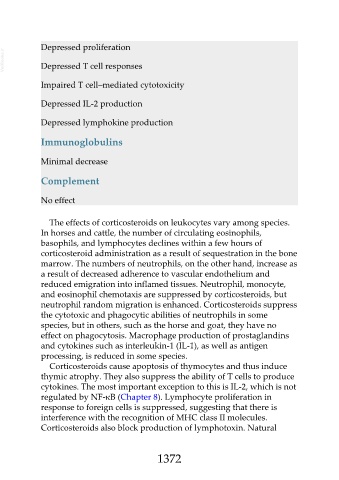Page 1372 - Veterinary Immunology, 10th Edition
P. 1372
Depressed proliferation
VetBooks.ir Depressed T cell responses
Impaired T cell–mediated cytotoxicity
Depressed IL-2 production
Depressed lymphokine production
Immunoglobulins
Minimal decrease
Complement
No effect
The effects of corticosteroids on leukocytes vary among species.
In horses and cattle, the number of circulating eosinophils,
basophils, and lymphocytes declines within a few hours of
corticosteroid administration as a result of sequestration in the bone
marrow. The numbers of neutrophils, on the other hand, increase as
a result of decreased adherence to vascular endothelium and
reduced emigration into inflamed tissues. Neutrophil, monocyte,
and eosinophil chemotaxis are suppressed by corticosteroids, but
neutrophil random migration is enhanced. Corticosteroids suppress
the cytotoxic and phagocytic abilities of neutrophils in some
species, but in others, such as the horse and goat, they have no
effect on phagocytosis. Macrophage production of prostaglandins
and cytokines such as interleukin-1 (IL-1), as well as antigen
processing, is reduced in some species.
Corticosteroids cause apoptosis of thymocytes and thus induce
thymic atrophy. They also suppress the ability of T cells to produce
cytokines. The most important exception to this is IL-2, which is not
regulated by NF-κB (Chapter 8). Lymphocyte proliferation in
response to foreign cells is suppressed, suggesting that there is
interference with the recognition of MHC class II molecules.
Corticosteroids also block production of lymphotoxin. Natural
1372

